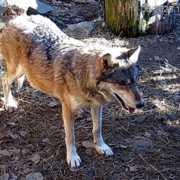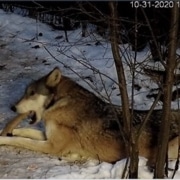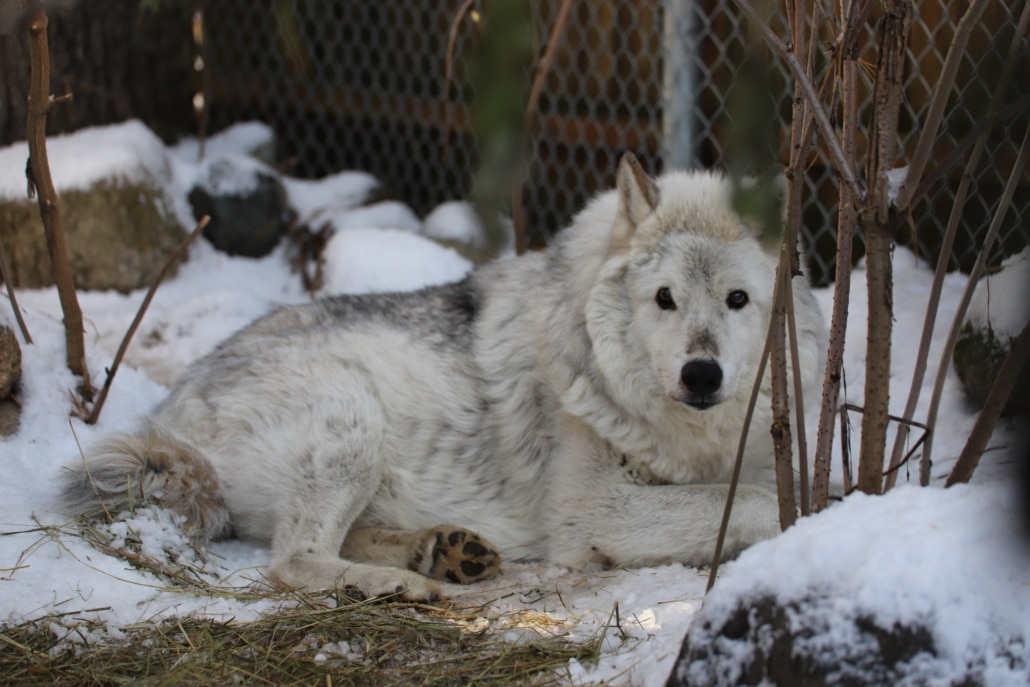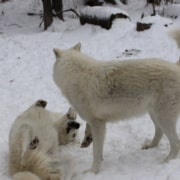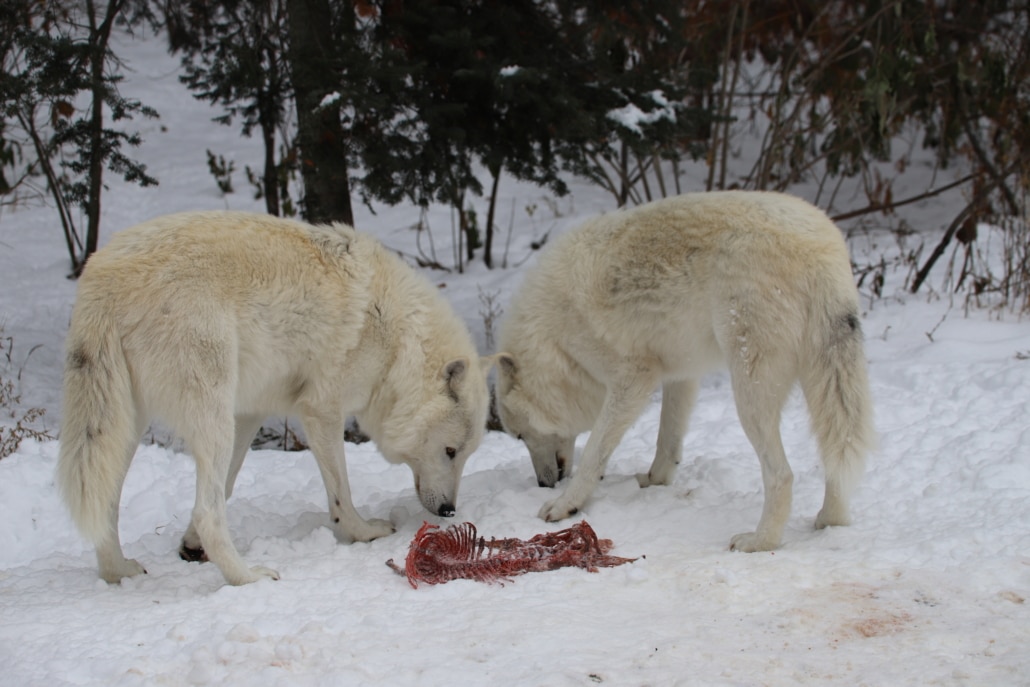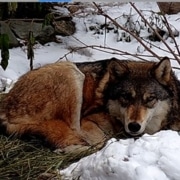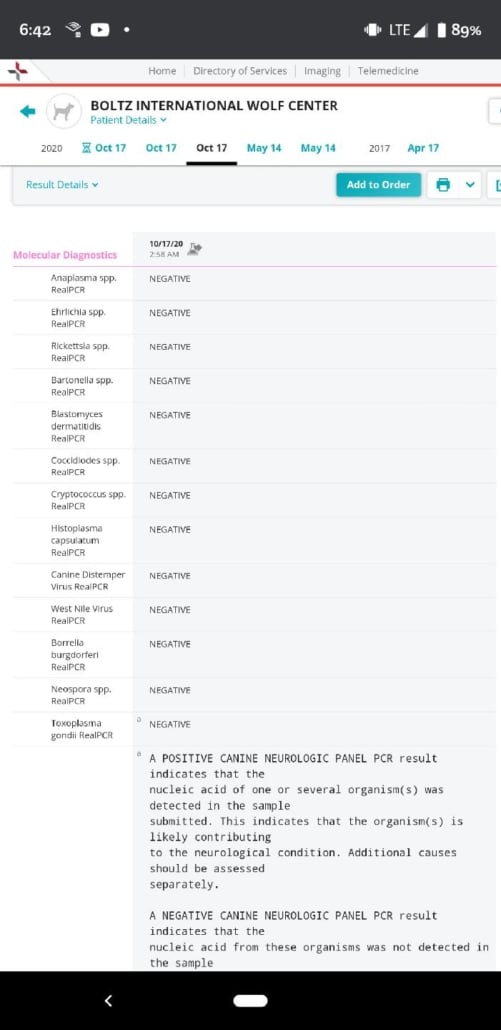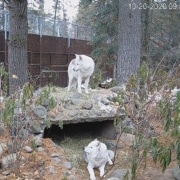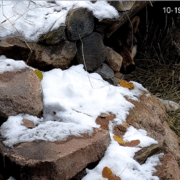Boltz completes his treatment for Myasthenia Gravis on Sunday. Unfortunately, there were no improvements seen in a week of treatment. We are preparing the USDA quality of life assessment that includes a behavioral assessment of alertness, pain response, social engagement, willingness to take food, tolerance of ambient temperatures, lack of tolerance for environmental changes and climatic stresses, ability to rest and impact of medical condition to behavioral stress. To accomplish this, we rely on our surveillance cameras, monitoring when he goes into the den at night, when he first rises in the morning and if there are instances where he rises during the night. At this time, all video shows Boltz getting a good night’s rest, often entering the den by 10 pm and not rising until after 6 am. Rest is certainly a beneficial component for his situation. Weather today is causing a challenge for all the wolves. The temperatures are expected to be record breaking in the high 70’s. This is causing Boltz and even Denali a bit more agitated with the heat.
Archives
After seeing Boltz get excited about a deer leg on Saturday night, I was hopeful that the new treatment for Myasthenia Gravis was helping. However, today he continues to have issues with back leg strength and mobility.
We will continue five more days of treatment and monitor his activity closely to assess improvement. The veterinarian has prepared me for the gravity of this condition. We have exhausted all test options for treatable conditions. All that is left are some invasive biopsies that wouldn’t yield any treatment options, only a diagnosis. The recommendation from the veterinarian is that we don’t need to put him through more painful invasive procedures while knowing there is no knowledge to be gained that would help him. Under permit from the USDA Animal Welfare Act, we are accountable for Boltz’s quality of life including what he endures during medical treatments. We will be assessing quality-of-life standards, both in his social and behavioral health, as well as his medical condition to determine what is best for Boltz
Boltz tested NORMAL for the mutated gene associated with Degenerative Myelopathy, meaning he does not have the mutation commonly known to cause the development of DM. Our vet decided to start treating him for Myasthenia Gravis, and if that is the cause, we would expect to see improvement in a week. Based on the extensive tests that have already been completed, the one remaining diagnosis being discussed is degenerative peripheral neuropathy which can be diagnosed by a nerve or muscle biopsy, but has no treatment. Since this condition has no treatment, our local vets and the neurological specialists concur that this more more invasive test would not be recommended at this time.
Written by Wolf Care Assistant Leanne Martin:
Written by Wolf Care Assistant – Leanne Martin
After Denali’s retirement on October 16th, Axel and Grayson needed some time to adjust to the change. I made the decision to retire Denali based on his advanced age needing some time to recuperate from a paw wound. On a younger animal, this would have been something that we would have treated within the pack, but an injury at this age increased his vulnerability. Since Denali’s retirement was not a situation where the arctics forced him out of the pack, we saw more stress howling, especially from Grayson. After about a week, the howling seemed to subside and Grayson has increased his displays of dominance, especially on the weekly deer carcass. Based on our experience with Shadow and Malik, the last pair of arctic wolves we managed, we know the winter will certainly be active for these two.
I don’t have anything to post on Boltz today, we are waiting for additional spinal tap test results to come in (if you recall, there were 3 tests). So, far everything has been negative and bloodwork is all in normal range. I have copied one of the reports here to see all the things that have been ruled out in this challenging time trying to get a diagnosis. The Vet put him back on prednisone as his condition was declining since we weaned him off of the prednisone to do the spinal tap. Now, we are closely monitoring him by camera and visual checks to assess if prednisone is working. Staff are diligent in reducing any distractions in the wolf yard that might impact his ability to comfortably rest. I hope to have more answers by the Monday Working for Wolves webinar at 5 pm Central time. There are still spots available for this webinar if you would like to register check our our Programs – Webinar tab on the website at www.wolf.org.
If you are a webcam viewer, you may have noticed that Denali and Grizzer are sharing the East Side Retirement and the Back Habitat. While reuniting the retired pack members was in my ongoing management plan, we had planned to wait until Denali was done with his antibiotics later this week to avoid food competition with medications. Apparently, Denali didn’t think much of my plan.
At 3:36 am this morning, In less than 30 seconds and with no agitation, Denali grabbed the gate frame, twisted the hinge on the gate (which staff couldn’t move with a pry bar and sledge hammer) and joined Grizzer in the Back Habitat. As a management policy, all external gates and gates between retirement and the Exhibit Pack are chained so if a gate hinge is compromised, the gate is still secure (we had an issue in 2008, where Lakota was reunited with the Exhibit Pack, led by Aidan and Denali). We also chain all external gates in the East Side Retirement area and Pack Holding Area, but since Grizzer has a history of grabbing chains in his younger years, we hadn’t used chains on the internal gates in retirement, except where Grizzer shares a gate with Boltz. The gate that Denali opened was an internal gate into the transition area. We have been watching Grizzer and Denali since last friday and all indications were good for a compatible introduction, the surveillance video confirmed our thoughts. Once again, we are so grateful for those of you who support our camera upgrades and robust surveillance system through generous donations. After this morning’s events, wolf care staff are now placing gate chains on ALL gates. One can’t assume that because wolves are older, that they won’t still act like wolves.
As Walter, one of our camera wolf watchers states: “They are not old, they are seasoned: as in there is very little you can throw at them or put in front of them they haven’t seen before or know how to deal with, including (apparently) wood reinforced chainlink metal framed gates”
If we find that Grizzer doesn’t like the arrangement, we will go back to keeping them separate, with a bolted gate. So far, Grizzer is following Denali around and it hasn’t impacted Grizzer from claiming his favorite spot in front of the Back Habitat den. Although since the weekend, he is not using the cover hay, so he may be getting some pain relief from the cold ground on his tendon. It is a form of self-medicating; Luna used to do the same thing.
Boltz is still being maintained separately in the Pack Holding Area until we have additional test results back. We ruled out cancer of the spine, bacterial or fungal issues, no meningitis, no tick related issues, no blastomycosis, the list is getting shorter. We will continue to host a separate log for Boltz under the Meet our Wolves section of the website
So far, the test results we are getting don’t show any abnormalities in the bloodwork. As I said in previous logs, he is otherwise in good health and doesn’t appear to be having a pain response, but his strength in his back legs is compromised. We received some preliminary results on the spinal tap and according to the lab report
” No obvious infectious etiologic (causing or contributing to the development of a disease or condition.) agents, malignant neoplastic cell populations (cells that could potentially invade and metastasize into cancer) , or atypical particulate matter are identified. The critical thinking and waiting game on additional samples continues.
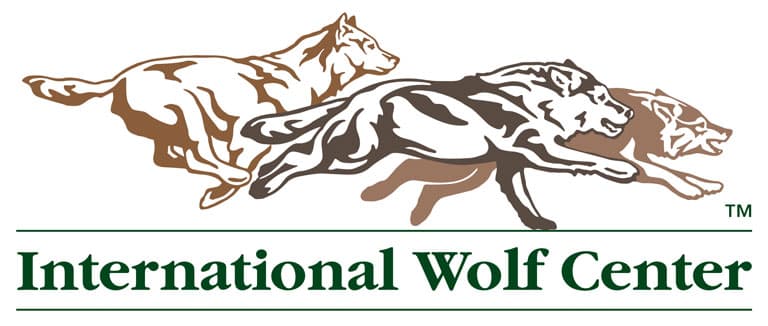
The International Wolf Center uses science-based education to teach and inspire the world about wolves, their ecology, and the wolf-human relationship.

